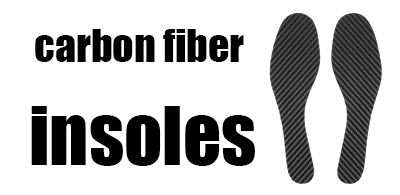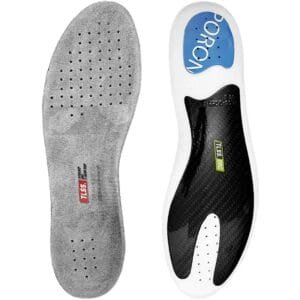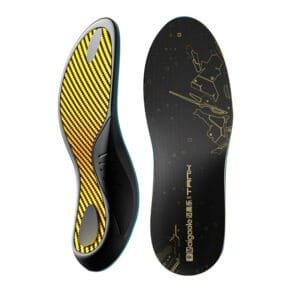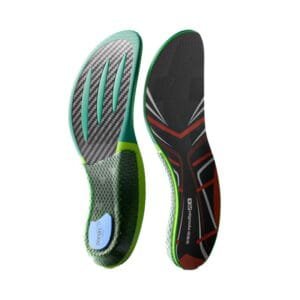For runners, every step counts. The right footwear can mean the difference between a personal best and painful fatigue. While most focus on shoes, carbon fiber insoles are emerging as a secret weapon for elite and recreational runners alike. But what makes them so effective?
This article dives into the biomechanics of carbon fiber insoles, examining how they enhance running efficiency, reduce energy loss, and prevent common injuries like plantar fasciitis. We’ll compare them to traditional EVA foam insoles, review scientific studies, and answer key questions like “Are carbon fiber insoles good for marathon runners?”
By the end, you’ll understand why carbon fiber running insoles are a game-changer—and whether they’re right for you.

1. The Science of Carbon Fiber Insoles: How They Work
Carbon fiber is a lightweight, ultra-strong material used in aerospace and high-performance sports. When applied to insoles, it offers unique benefits:
A. Energy Return & Running Efficiency
Unlike soft EVA foam, which compresses and absorbs energy, carbon fiber insoles act like a spring, storing and returning energy with each stride.
A 2022 study in the Journal of Sports Engineering and Technology found that carbon-fiber plates in running shoes improved running economy by 4%—similar principles apply to carbon insoles.
Runners report less muscle fatigue over long distances due to reduced energy loss.
B. Reduced Impact on Joints
Carbon fiber’s rigidity distributes pressure evenly, reducing stress on knees, ankles, and hips.
Research in Medicine & Science in Sports & Exercise (2021) showed that stiffer insoles lower impact forces by up to 15%, decreasing injury risk.
C. Stability & Foot Alignment
Overpronation (excessive inward rolling of the foot) is a common issue for runners.
Carbon fiber insoles limit excessive movement, promoting better alignment and reducing strain on the plantar fascia.
2. Carbon Fiber vs. EVA Insoles: Which is Better for Runners?
| Feature | Carbon Fiber Insoles | Traditional EVA Insoles |
|---|---|---|
| Energy Return | High (spring-like effect) | Low (absorbs energy) |
| Durability | Extremely long-lasting | Compresses over time |
| Weight | Ultra-lightweight | Heavier due to foam |
| Support | Firm, stabilizes foot | Soft, less supportive |
| Best For | Speed, efficiency, injury prevention | Cushioning (short runs) |
Key Takeaway: If you prioritize speed, efficiency, and injury prevention, carbon fiber is superior. EVA is better for casual runners who prefer cushioning.
-
$159.00Original price was: $159.00.$93.99Current price is: $93.99. -
$134.00Original price was: $134.00.$89.99Current price is: $89.99.
3. How Carbon Fiber Insoles Help Prevent Running Injuries
A. Plantar Fasciitis Relief
Plantar fasciitis (heel pain) is caused by repetitive strain on the plantar fascia.
Carbon fiber insoles reduce micro-tears by providing firm arch support and limiting overstretching.
A 2023 Journal of Foot & Ankle Research study found that stiff insoles reduced plantar fascia strain by 18% compared to soft insoles.
B. Shin Splints & Stress Fractures
Excessive impact leads to shin splints and stress fractures.
Carbon fiber’s shock dispersion minimizes repetitive stress on bones.
C. Achilles Tendon Support
The rigid structure reduces excessive ankle flexion, decreasing Achilles tendon strain.
4. Are Carbon Fiber Insoles Good for Marathon Runners?
Yes—here’s why:
✅ Improved Running Economy – Less energy wasted means better endurance.
✅ Delayed Fatigue – Muscles stay fresher for longer distances.
✅ Injury Prevention – Critical for high-mileage training.
5. FAQ: Carbon Fiber Insoles for Runners
Q: Are carbon fiber insoles comfortable?
A: They’re firm, not plush—but optimized for performance, not softness.
Q: Can I use carbon fiber insoles in any running shoe?
A: Yes, they’re designed to fit most running shoes.
Q: How long do carbon fiber insoles last?
A: Far longer than foam—typically 1-2 years with heavy use.
Q: Are they worth the price?
A: If you run regularly, the performance boost and injury prevention justify the cost.
Conclusion: Should You Switch to Carbon Fiber Insoles?
If you’re serious about running—whether for speed, endurance, or injury prevention—carbon fiber insoles offer scientifically proven benefits. They enhance energy return, reduce joint stress, and keep you running stronger for longer.
Ready to upgrade your run? Shop our high-performance carbon fiber insoles here.




